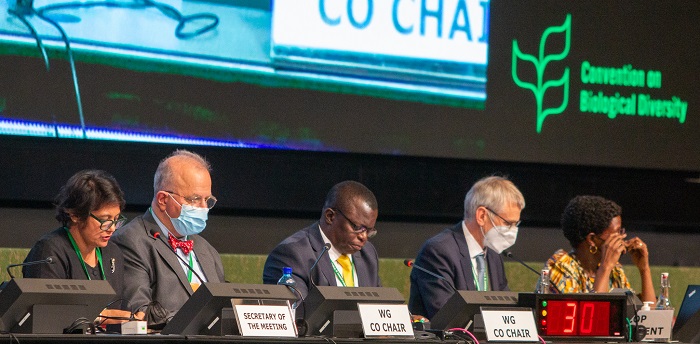Following 15 days of negotiation in Geneva, world governments have produced what looks like a strong basis for a post 2020 global biodiversity framework to safeguard the health of the planet, scheduled for final agreement at UN Biodiversity Conference in Kunming, China this year.

“Governments came to Geneva eager to meet in person and make progress on urgent action on the goals, targets and institutions needed to protect nature,” said Elizabeth Maruma Mrema, Executive Secretary of the Convention on Biological Diversity, “They have engaged in intense discussions drawing a variety of positions and shown the power of multilateralism and a willingness to seek common ground.”
“When we started the meeting, the text under discussion was our proposed first draft,” said Francis Ogwal, who with Basile van Havre are co-chairs of the Global Biodiversity Framework negotiations working group. “Following the engagement and discussions here in Geneva, this text is now clearly that of world governments and we are in a Party-led process.”
“During the session, governments retained the overall shape and structure of the first version of the framework, which includes goals, targets, and means of implementation, but added many other elements and qualification that require further negotiation,” said Mr. van Havre. “These will be held in June in Nairobi, where delegates will further refine the framework and agree on language to present for adoption in Kunming.”
The overarching goals of the draft framework – to protect the elements of biodiversity at all levels (genetic, species and ecosystem), sustainability and human well-being in the use of biodiversity, and the fair and equitable sharing of benefits from the use of biodiversity – were reaffirmed during the Geneva sessions. Many suggestions added to the text, as well as milestones to assess progress, require additional consideration, with governments differing on the need and pacing.
The 21 draft targets for the framework also took centre stage in discussions, with extensive engagement and suggestions for added elements coming from all Parties and regions. The intense discussions and high level of engagement by delegates led to extensive discussions, meaning that much of the text will require streamlining. However, this shows that world governments hold great importance to the discussions.
Important late-night discussions on Sunday, March 27 on the relationship between the framework and the issue of digital sequence information, and the equitable sharing of its benefits from its use, produced a strong text that brings together the views of many regions, provider and user groups and countries.
The complex and new issue of benefit-sharing resulting from the use of information provided as a result of digital sequence information-related technologies has emerged as a central issue for many Parties to the CBD and its Nagoya Protocol on Access and Benefit-sharing.
The resumed meetings of the Subsidiary Body on Scientific, Technical and Technological Advice (SBSTTA 24), the Subsidiary Body on Implementation (SBI 3) and the Open-ended Working Group on the Post-2020 Global Biodiversity Framework (WG2020-3) were also held concurrently from March 14 to 29, 2022, at the Centre International de Conférences Genève.
The draft framework working group discussions were complemented by important deliberations within the Convention’s subsidiary bodies on science and implementation.
The science body, SBSTTA, had extensive discussions on monitoring progress, examining existing and proposed new indicators, using a “traffic-light” system to judge the readiness of different indicators.
“Parties have taken the time to provide the best available scientific advice in support of this ambitious framework,” said Hesiquio Benitez, Chair of SBSTTA-24. “We will continue these discussions in the intersessional period.”
The Subsidiary Body on Implementation, SBI, completed important work on ensuring the mobilisation and scaling-up of finance for biodiversity, including a resource mobilisation strategy and the role of the Global Environment Facility, as well as a mechanism to keep the implementation of the Convention under review, to allow for course corrections in Convention policy.
“The discussions in the Convention’s body to keep implementation under review showed that there is a great deal of work to do,” said Charlotta Sörqvist, SBI-3 Chair. “But it also showed a tremendous willingness to work towards compromise and a consensus.”
On the closing day, governments agreed on ways to advance work in the lead up to the UN Biodiversity Conference later in the year.
The UN Biodiversity Conference will take place in the third quarter of 2022; exact dates remain to be determined.
Other results from the meeting
SBSTTA-24 adopted recommendations on marine and coastal biodiversity, the draft updated plan of action 2020-2030 for the international initiative for the conservation and sustainable use of soil biodiversity, biodiversity and health, invasive alien species, synthetic biology, risk assessment and risk management of living modified organisms, and the programme of work of the Intergovernmental Science-Policy Platform on Biodiversity and Ecosystem Services.
A recommendation on marine and coastal biodiversity did not include consensus, and more work will be done before Kunming.
SBI-3 also agreed on recommendations related to implementation of the Cartagena Protocol on Biosafety, and the Nagoya Protocol on Access and Benefit-sharing.
